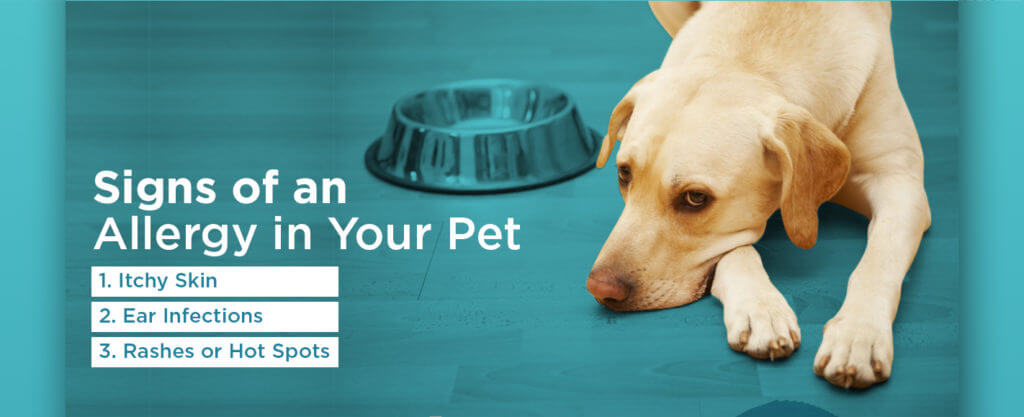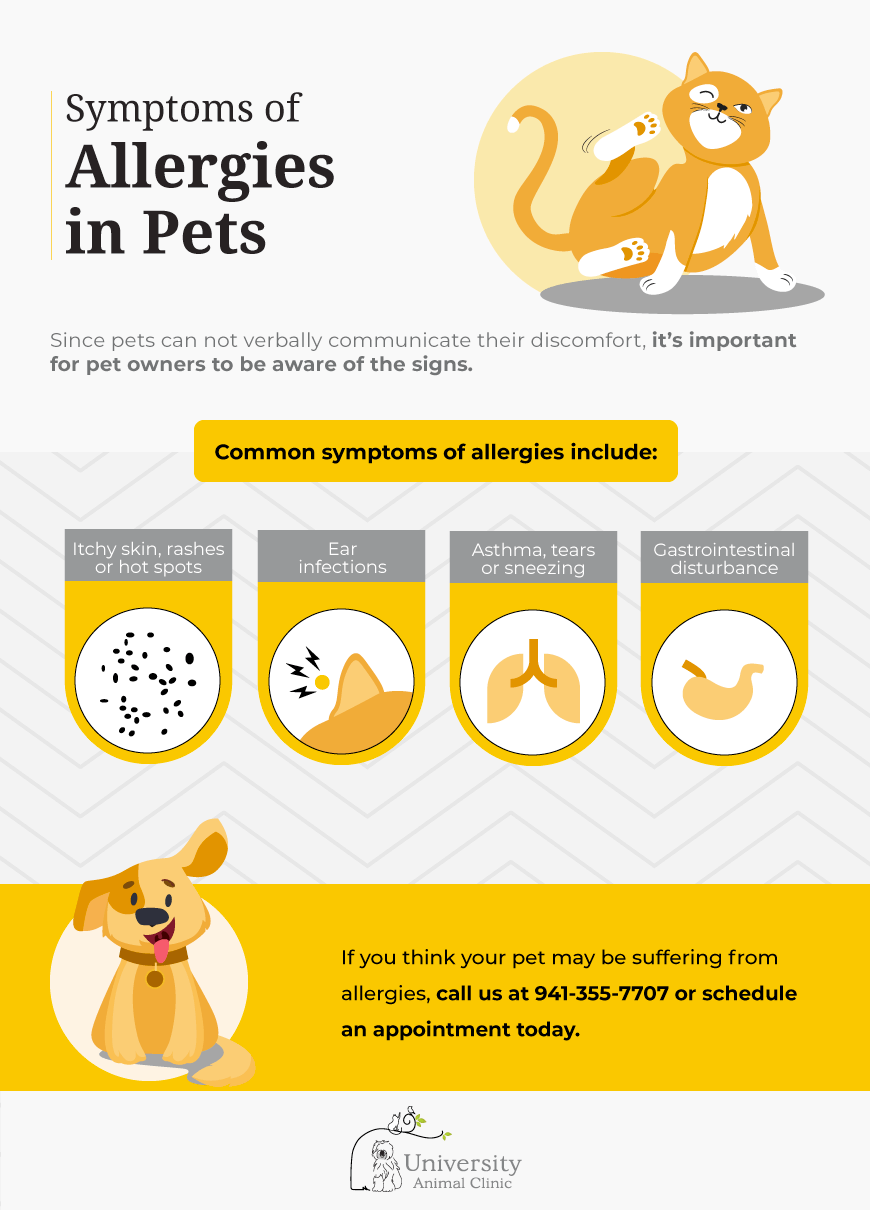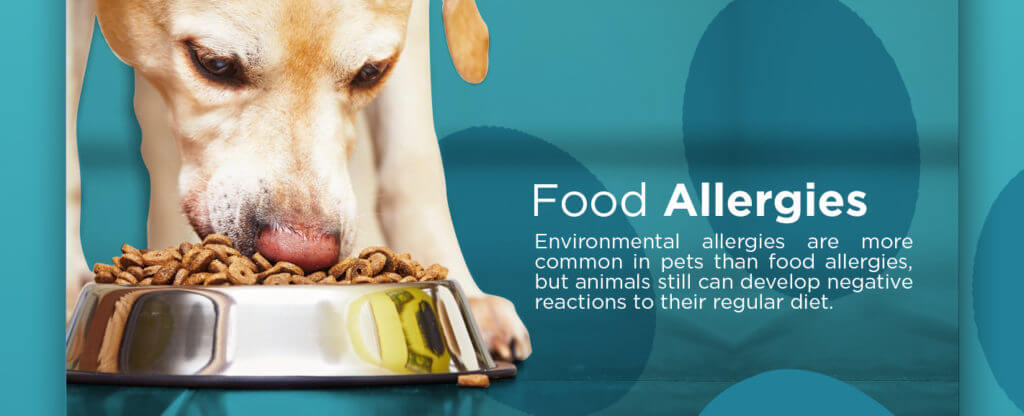
As much as we want to, sometimes it’s difficult to understand what is going on with our pets. They function differently than we do, even with conditions like allergies. Although similar factors set off animal allergies, pets don’t react the same way as humans — for instance, you might be wondering, “why is my dog itching?”
Allergens cause discomfort in different areas for pets. In humans, allergies often have a respiratory component, but in pets, their skin is the primary indication of an allergy. Check out the following explanations to find out if your pet has an allergic reaction.

Signs Of An Allergy In Your Pet
While it is easy to spot if a person has allergies, with a runny nose, puffy eyes, etc., animals react differently to allergies. The skin is the allergy organ of pets rather than the respiratory system, like in humans. This means your dog, cat or rabbit will likely not sneeze and cough to indicate the irritation to their system. Instead, their skin will be irritated and itchy. The following signs can indicate that your pet is dealing with allergies:
1. Itchy Skin
If your pet is plagued by itches and is suddenly prone to scratching, they might have allergies. There could be a single area that is particularly bothersome, or many. Common locations where allergic reactions tend to occur are on areas like the face, ears, paws, groin, armpits or rump.
Often, dogs and cats will chew their paws since the skin is exposed on their padded feet without fur blocking their path. They may attempt to lick or rub other parts of the body, too. This is a fairly common behavior in normal circumstances, but repeated or aggressive pawing, gnawing or scooting in an attempt to relieve their itchy areas can indicate their problem with allergens.
2. Ear Infections
Not all ear infections are due to allergies, as frequent playing in water can also cause this. But allergies often are overlooked as causes of ear infection. The inside of the ear still contains skin, so it can become inflamed and infected as much as any other part of the body. If your dog or cat is scratching or rubbing their ears, they may be reacting to allergies.
3. Rashes Or Hot Spots
Hot spots, which are inflamed areas on your pet’s skin, usually occur in dogs rather than cats. These infected red spots appear when the bacteria in your pet’s skin is concentrated in that area. Your pet may lose hair in that spot, and the hot spot will be sensitive. The hips and chest are the most common places that these arise, and your pet’s scratching and biting will worsen the hot spot, requiring a longer healing period.
4. Asthma
While coughing and congestion are not common signs of allergies in animals, asthma and coughing do show up in some cases. Cats can react from allergies by trying to expel allergens that they ingested. Wheezing may also show up. However, this is much less common than itchy skin when pets are struggling with allergies.
5. Tears And Sneezing
Respiratory symptoms like tears and sneezing can happen with pets who have allergies, and sometimes, redness in the eyes and face can be an indication of seasonal allergies. However, it’s redness in the paws and body that are the more frequent telltale sign of an allergy.
6. Gastrointestinal Disturbance
The anal area might appear red and be itchy, but diarrhea can be a sign of allergies, too. Vomiting and digestive problems occur in many pets with allergies. Flatulence also accompanies allergies at times. A decrease in appetite may also be a sign of allergies.

Common Pet Allergy Causes
While the symptoms of allergic reactions might be different in an animal than a human, there are still several components that can trigger a reaction. Here are some of the most common ones:
1. Environmental Allergies
Depending on where you and your pet call home, your pet may be reacting to certain plants, seasonal changes or moldy areas around you. Other factors like dust, dander and particles in the air may also irritate your animal. Even taking your pet on a walk down the street can introduce them to unfamiliar substances, like rainwater or plants in the neighbor’s garden, that can initiate a response.
Plants To Avoid
Pollen, which plants produce, causes negative reactions in many people and animals. Certain plants expel more pollen than others. The trees you should avoid to keep your pet’s allergies at bay are birch, elm, cedar, oak, poplar, walnut and pine. Other plants that can trigger allergic symptoms from their pollen output include ragweed, Bermuda grass, bluegrass and nettle. Try to keep your pet from contact with male juniper and yew, too. Sagebrush, daylily and primrose also irritate upon skin contact.
Seasonal Allergies In Cats & Dogs
Seasonal changes spark allergy symptoms due to pollen output in the spring. When pollen enters your environment again with warmer weather and your dog or cat begins to scratch, it could be an environmental allergy disrupting your pet’s day-to-day life. However, if you live in an area with few differences from summer to winter, it can be difficult to identify allergies to grasses and other plants that don’t die off. Your pet may be allergic to a kind of grass that sticks around all year.
Other Environmental Factors
Things in your home could be setting off your pet’s allergies, too. Mold is a typical environmental allergen that you may not know is in your house. Spores can appear in your kitchen, bathroom and other damp places, creating an irritant for your animal’s immune system. Carpet fibers and certain fabrics can even retain indoor allergens. Dust mites, which often appear during the winter, can be bothering your pet as well.
How To Prevent Environmental Allergy Symptoms For Dogs And Cats
Seasonal allergies for pets are difficult to avoid, but you can control several environmental factors that are affecting your pet. Diminish the effects of indoor allergens by reducing pollen buildup. Regular baths for your animal can get rid of pollen, dust and mites that attach to their skin or fur. Clean the house frequently during seasonal changes to keep allergens at bay, and introduce dehumidifiers into moist areas of your home to prevent mold. If you do notice mold build up, be proactive in eliminating it.
Your vet may perform a skin test or blood test on your pet to determine if the most common environmental allergens give them a reaction. However, these are often inconclusive. Consult your veterinarian to determine what steps you can take to protect your pet from environmental allergens.

2. Food Allergies
Environmental allergies are more common in pets than food allergies, but animals still can develop negative reactions to their regular diet. There are many myths about what ingredients cause your pet harm in their food. Allergies to food are an immune response, normally to animal proteins, but your pet’s unique system can be more sensitive to a food and react in an unusual way. It’s also more likely for your pet to develop an allergy to foods in their regular diet — as the allergic reaction develops over time — rather than something that has been just introduced.
Animal Proteins
Prevalent food allergies in pets usually consist of animal proteins — because these are the foods that most animals eat regularly. Dairy and egg allergies are also frequently reported, as well as fish allergies for cats.
While protein is necessary for a pet’s diet, the proteins of certain things, like chicken, beef and pork, could trigger your pet’s immune system, leading to the allergy.
Grain Or Gluten-Free Diets
Gluten is one of the substances that pets rarely form an allergy to, although many food companies present gluten-free food as the solution to your pet’s allergies. No evidence sufficiently indicates that grain-free food is better for pets with allergies, however. Each individual pet with allergy symptoms has to be tested to identify their particular allergy, and gluten-free food cannot cure all allergic animals. Even corn, which is often relegated to simply a filler ingredient, is not a harmful ingredient to animals and can actually be beneficial unless a certain animal is allergic to it.
Signs Of Pet Food Allergies
In cats, food allergies are evident from skin lesions that form and burst, causing itching and further wounds from scratching. Additionally, the fur coat by becoming shorter or start to thin due to an allergy. Other pets also experience itching, loss of appetite and skin rashes or wounds. Gastrointestinal discomfort can happen as well with symptoms such as vomiting or diarrhea.
How To Treat Pet Food Allergies
Instead of turning to a food labeled gluten-free or allergen-free, consult your veterinarian about a diet trial. They will help you decide the course of action to evaluate your pet’s diet. Elimination trials are best guided by a professional. Usually, the food to which your pet is allergic has been in their diet for about two years, which means the ingredient is a familiar one. Typically, you will limit your pet to a diet of a new protein and carbohydrate source that is different than their current food. You should also remove any other flavored additives, like treats or rawhide, from your pet’s diet. Even chew toys can disrupt an elimination trial.

3. Flea Allergies
A flea allergy is more than reacting to flea bites with a normal level of scratching. Hypersensitivity to fleas happens when flea saliva irritates an animal’s skin. When fleas bite animals, their saliva comes into direct contact with the pet’s skin. Prolonged scratching and discomfort from flea bites can create skin wounds that may become infected.
Flea Allergy Dermatitis
Flea allergy dermatitis is the term for a pet’s intense reaction to flea saliva. Adult fleas can bite your dog or cat during any season, but frequently, these allergic reactions occur in the summer. A humid and warm setting helps fleas produce and grow in number. Your pet’s fur fits these conditions during the summer, too, which makes it a desirable spot for fleas to settle in. Over time, this allergy develops, so if your pet has not been overly sensitive to fleas in the past, they still might form an allergy later on in their life.
Signs Of Flea Allergies
If your pet is scratching or rubbing significantly more than normal and you find signs of fleas or bites on their skin, your pet may have a flea allergy. Check to see if the areas around flea bites are red and inflamed. Around the tail, rear and abdomen are common spots for dogs to develop inflamed flea bites. For cats, the neck, as well as the lower back and tail area, are also targeted by fleas. It only takes a few bites for your animal to undergo extreme itching and skin irritation.
Examine your pet by looking at their back or belly areas. Fleas are normally visible if they are present. You may need to comb through or spread apart your pet’s hair to get a closer view of the skin. You will not only notice the presence of fleas if your pet is allergic to their saliva. Red spots surrounding the bites will tell your vet whether or not your animal has an allergy. Scabs, bumps, hair loss and hot spots are all possible signs of a flea allergy.
How To Prevent Flea Allergies
Preventative flea measures include oral pills, collars and topical ointments. Topical ointments can arm your pet against fleas. Adulticide ointments can be regularly applied to keep fleas from harming your pet. These are safe options because they remain on the skin, which is where your pet’s reaction is located, rather than absorbing into the bloodstream. The pill version of this may be a better choice for your animal.
A flea collar that targets juvenile fleas is effective at preventing infestations. Be wary of insecticidal flea collars, though, and don’t use them without additional preventatives. Preventatives that interrupt the life cycle of fleas are better at eliminating infestations. Cats are more sensitive to certain insecticides, so be careful in your choice of flea medication.
How To Treat Flea Allergies
If preventative measures fail or an existing infestation is plaguing your pet, you can treat your pet’s allergy with medication and ointment to ease the itching. An oral or a topical medication can reduce the pain and constant itching, and some vets also prescribe an injected medicine to reduce these symptoms. If inflammation has led to wound infection, you may need an antibiotic for your animal. A cool bath can also relieve your pet’s skin and wash away fleas.

Consult Your Veterinarian
Preventative measures and treatment methods differ for each pet, but your veterinarian can assist you in with the best plan for your pet. A professional’s opinion is the deciding factor on what is causing the allergic reaction in your pet. Whether your pet has a food, environmental or flea allergy, your vet can help relieve your pet’s itchy skin and reduce the chances of future reactions.
University Animal Clinic is an accredited AAHA hospital with staff members who are dedicated to the care of our clients and their pets. We specialize in companion animals, including exotics. You can be confident that our general practice veterinarian hospital has high medical quality for your pet. With our passion for preventive care, we also offer wellness plans to get your four-legged family member the best medical care available.
Contact us today to find out about our treatment methods and preventative steps for all types of allergies.
